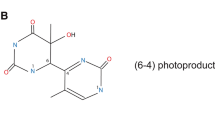Abstract
XERODERM A pigmentosum patients with a defect in the nucleotide-excision repair gene XPA are characterized by, for example, a > 1,000-fold higher risk of developing sunlight-induced skin cancer1–3. Nucleo tide-excision repair (NER) is involved in the removal of a wide spectrum of DNA lesions. The XPA protein functions in a pre-incision step, the recognition of DNA damage4–7. To permit the functional analysis of the XPA gene in vivo, we have generated XPA -deficient mice by gene targeting in embryonic stem cells. The XPA−f− mice appear normal, at least until the age of 13 months. XPA−1− mice are highly susceptible to ultraviolet (UV)-B-induced skin and eye tumours and to 7,12-dimethylbenz-[a]anthracene (DMBA)-induced skin tumours. We conclude that the XPA-deficient mice strongly mimic the phenotype of humans with xeroderma pigmentosum.
Similar content being viewed by others
References
Cleaver, J. E. & Kraemer, K. H. in The Metabolic Basis of Inherited Disease Vol 2 (eds Scriver, C. R., Beaudet, A. L, Sly, W. S. & Valle, D.) 2949–2971 (McGraw-Hill, New York, 1989).
Hoeijmakers, J. H. J. & Bootsma, D. Cancer Cells 2, 311–320 (1990).
Satokata, I., Tanaka, K. & Okada, Y. Hum. Genet. 88, 603–607 (1992).
Sancar, A. Science 266, 1954–1956 (1994).
Grossman, L. & Thiagalingam, S. J. biol. Chem. 268, 16871–16874 (1993).
Robins, P., Jones, C. J., Biggerstaff, M., Lindahl, T. & Wood, R. EMBO J. 10, 3913–3921 (1991).
Guzder, S. N., Sung, P., Prakash, L. & Prakash, S. Proc. natn. Acad. Sci. U.S.A. 90, 5433–5437 (1993).
Tanaka, K. et al. Nature 348, 73–76 (1990).
Maher, V. M. & McCormick, J. J. Pharmac. Ther. 25, 395–408 (1984).
de Gruijl, F. R. & van der Leun, J. C. Cancer Res. 51, 979–984 (1991).
van Oostrom, C. Th.M., de Vries, A., Verbeek, S. J., van Kreijl, C. F. & van Steeg, H. Nucleic Acids Res. 22, 11–14 (1994).
Fort, P. et al. Nucleic Acids Res. 13, 1431–1442 (1985).
Adra, C. N., Boer, P. H. & McBurney, M. W. Gene 60, 65–74 (1987).
Hooper, M., Hardy, K., Handyside, A., Hunter, S. & Monk, M. Nature 326, 292–295 (1987).
te Riele, H., Maandag, E. R., Clarke, A., Hooper, M. & Berns, A. Nature 348, 649–651 (1990).
Bradley, A., Evans, M., Kaufman, M. H. & Robertson, E. Nature 309, 255–258 (1984).
van Vuuren, A. J. et al. EMBO J. 13, 1645–1653 (1994).
Author information
Authors and Affiliations
Rights and permissions
About this article
Cite this article
Vries, A., van Oostrom, C., Hofhuis, F. et al. Increased susceptibility to ultraviolet-B and carcinogens of mice lacking the DNA excision repair gene XPA. Nature 377, 169–173 (1995). https://doi.org/10.1038/377169a0
Issue Date:
DOI: https://doi.org/10.1038/377169a0
- Springer Nature Limited
This article is cited by
-
Persistent TFIIH binding to non-excised DNA damage causes cell and developmental failure
Nature Communications (2024)
-
An immunomodulating peptide to counteract solar radiation-induced immunosuppression and DNA damage
Scientific Reports (2023)
-
Chemically induced carcinogenesis in rodent models of aging: assessing organismal resilience to genotoxic stressors in geroscience research
GeroScience (2019)
-
The capacity of oocytes for DNA repair
Cellular and Molecular Life Sciences (2018)
-
Current Perspective in the Discovery of Anti-aging Agents from Natural Products
Natural Products and Bioprospecting (2017)





